Principles of Project Management: Uber Driver App Reflection Report
VerifiedAdded on 2023/03/17
|9
|2311
|63
Report
AI Summary
This report provides a comprehensive reflection on project management principles, utilizing the case study of the Uber Driver App. It delves into the application of Project Management Body of Knowledge (PMBOK) knowledge areas and processes, highlighting their impact on project success and adherence to the Project Management Institute (PMI) code of ethics. The report critically compares and contrasts various project management approaches, assessing their suitability for the Uber app project. It further explores the application of project management tools and techniques, particularly in risk mitigation. The reflection also examines the importance of leadership styles in managing dynamic project situations, concluding with insights into the app's success and its implications for both drivers and delivery partners. The report emphasizes the significance of project management theories, practices, and tools in achieving long-term project objectives.
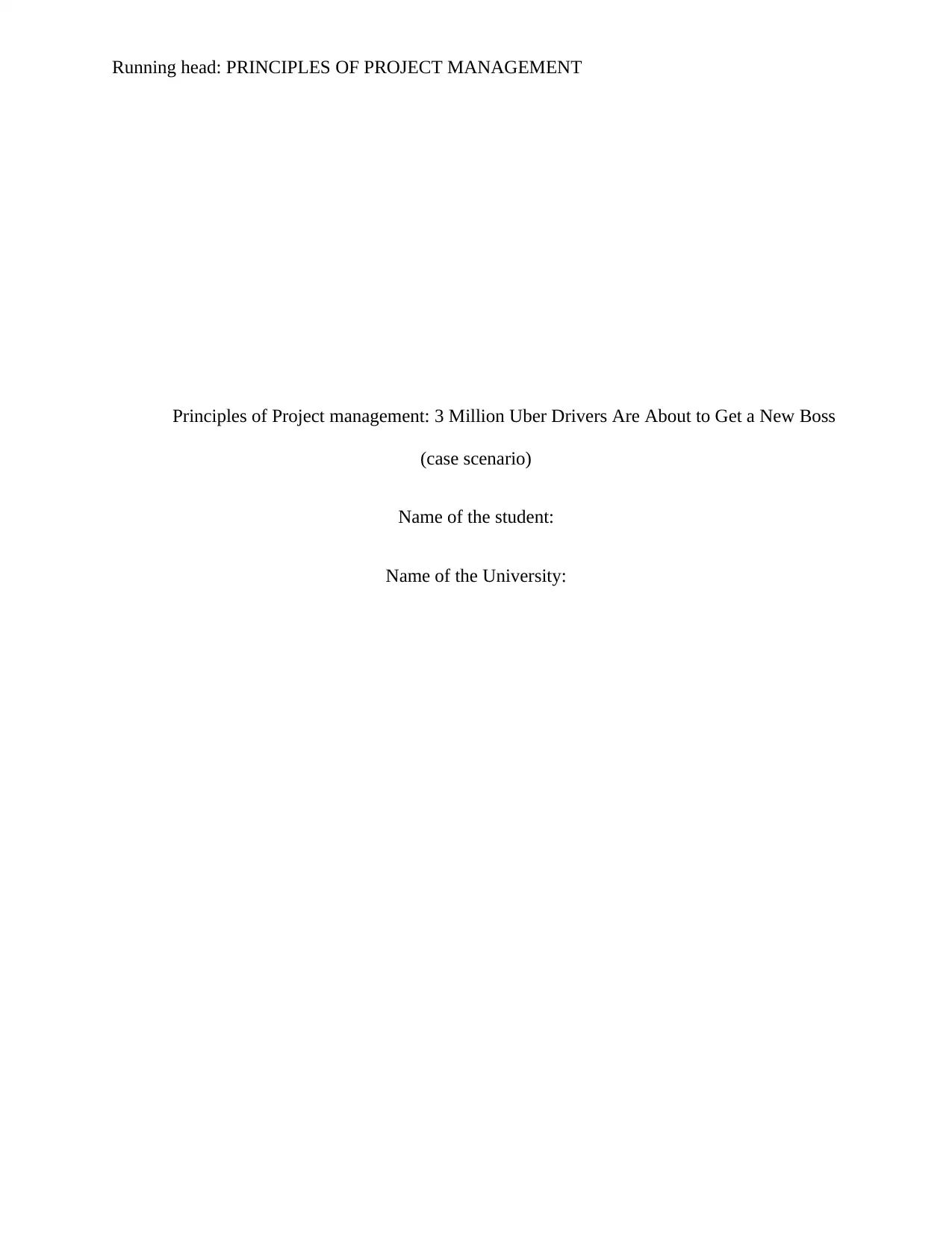
Running head: PRINCIPLES OF PROJECT MANAGEMENT
Principles of Project management: 3 Million Uber Drivers Are About to Get a New Boss
(case scenario)
Name of the student:
Name of the University:
Principles of Project management: 3 Million Uber Drivers Are About to Get a New Boss
(case scenario)
Name of the student:
Name of the University:
Paraphrase This Document
Need a fresh take? Get an instant paraphrase of this document with our AI Paraphraser
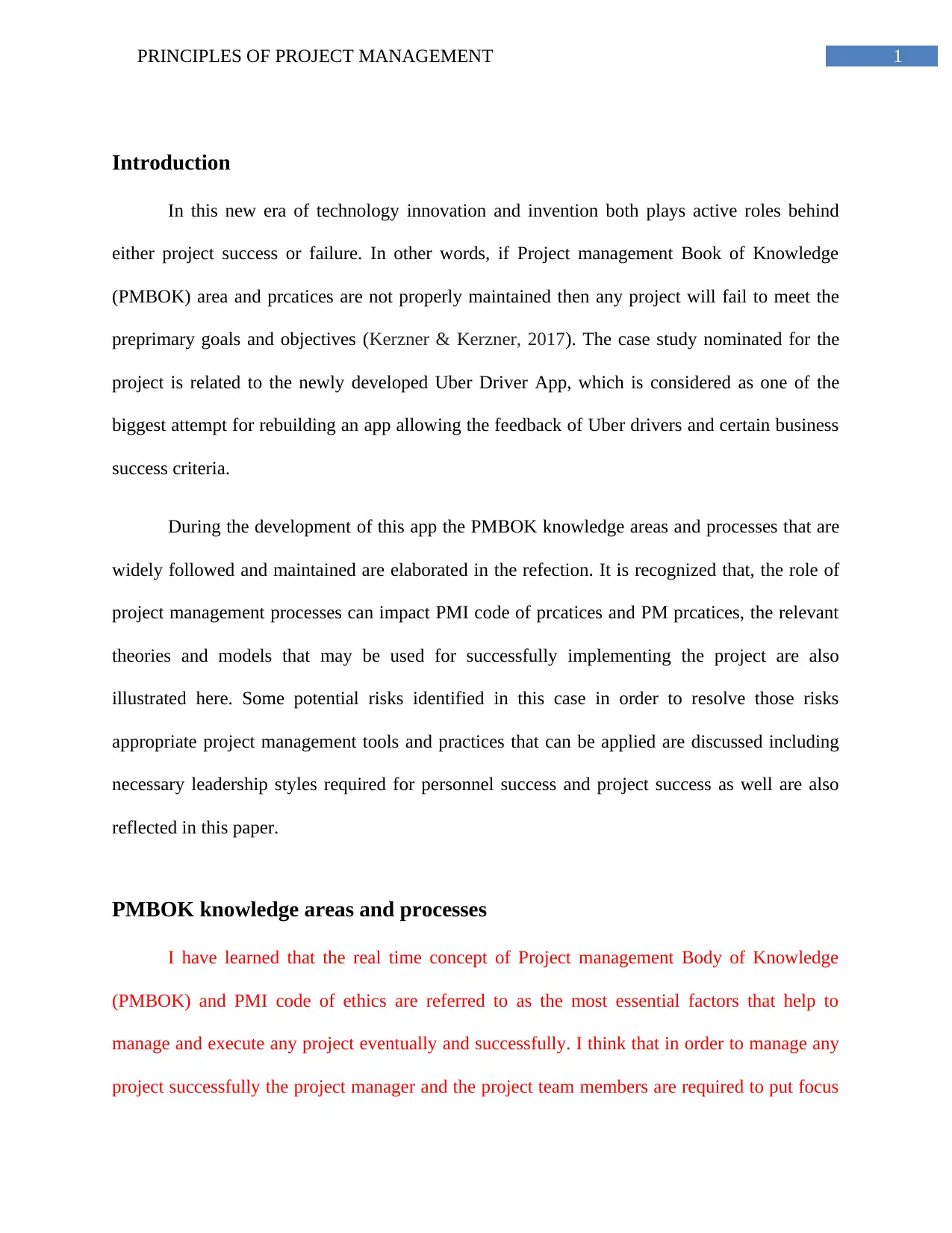
1PRINCIPLES OF PROJECT MANAGEMENT
Introduction
In this new era of technology innovation and invention both plays active roles behind
either project success or failure. In other words, if Project management Book of Knowledge
(PMBOK) area and prcatices are not properly maintained then any project will fail to meet the
preprimary goals and objectives (Kerzner & Kerzner, 2017). The case study nominated for the
project is related to the newly developed Uber Driver App, which is considered as one of the
biggest attempt for rebuilding an app allowing the feedback of Uber drivers and certain business
success criteria.
During the development of this app the PMBOK knowledge areas and processes that are
widely followed and maintained are elaborated in the refection. It is recognized that, the role of
project management processes can impact PMI code of prcatices and PM prcatices, the relevant
theories and models that may be used for successfully implementing the project are also
illustrated here. Some potential risks identified in this case in order to resolve those risks
appropriate project management tools and practices that can be applied are discussed including
necessary leadership styles required for personnel success and project success as well are also
reflected in this paper.
PMBOK knowledge areas and processes
I have learned that the real time concept of Project management Body of Knowledge
(PMBOK) and PMI code of ethics are referred to as the most essential factors that help to
manage and execute any project eventually and successfully. I think that in order to manage any
project successfully the project manager and the project team members are required to put focus
Introduction
In this new era of technology innovation and invention both plays active roles behind
either project success or failure. In other words, if Project management Book of Knowledge
(PMBOK) area and prcatices are not properly maintained then any project will fail to meet the
preprimary goals and objectives (Kerzner & Kerzner, 2017). The case study nominated for the
project is related to the newly developed Uber Driver App, which is considered as one of the
biggest attempt for rebuilding an app allowing the feedback of Uber drivers and certain business
success criteria.
During the development of this app the PMBOK knowledge areas and processes that are
widely followed and maintained are elaborated in the refection. It is recognized that, the role of
project management processes can impact PMI code of prcatices and PM prcatices, the relevant
theories and models that may be used for successfully implementing the project are also
illustrated here. Some potential risks identified in this case in order to resolve those risks
appropriate project management tools and practices that can be applied are discussed including
necessary leadership styles required for personnel success and project success as well are also
reflected in this paper.
PMBOK knowledge areas and processes
I have learned that the real time concept of Project management Body of Knowledge
(PMBOK) and PMI code of ethics are referred to as the most essential factors that help to
manage and execute any project eventually and successfully. I think that in order to manage any
project successfully the project manager and the project team members are required to put focus
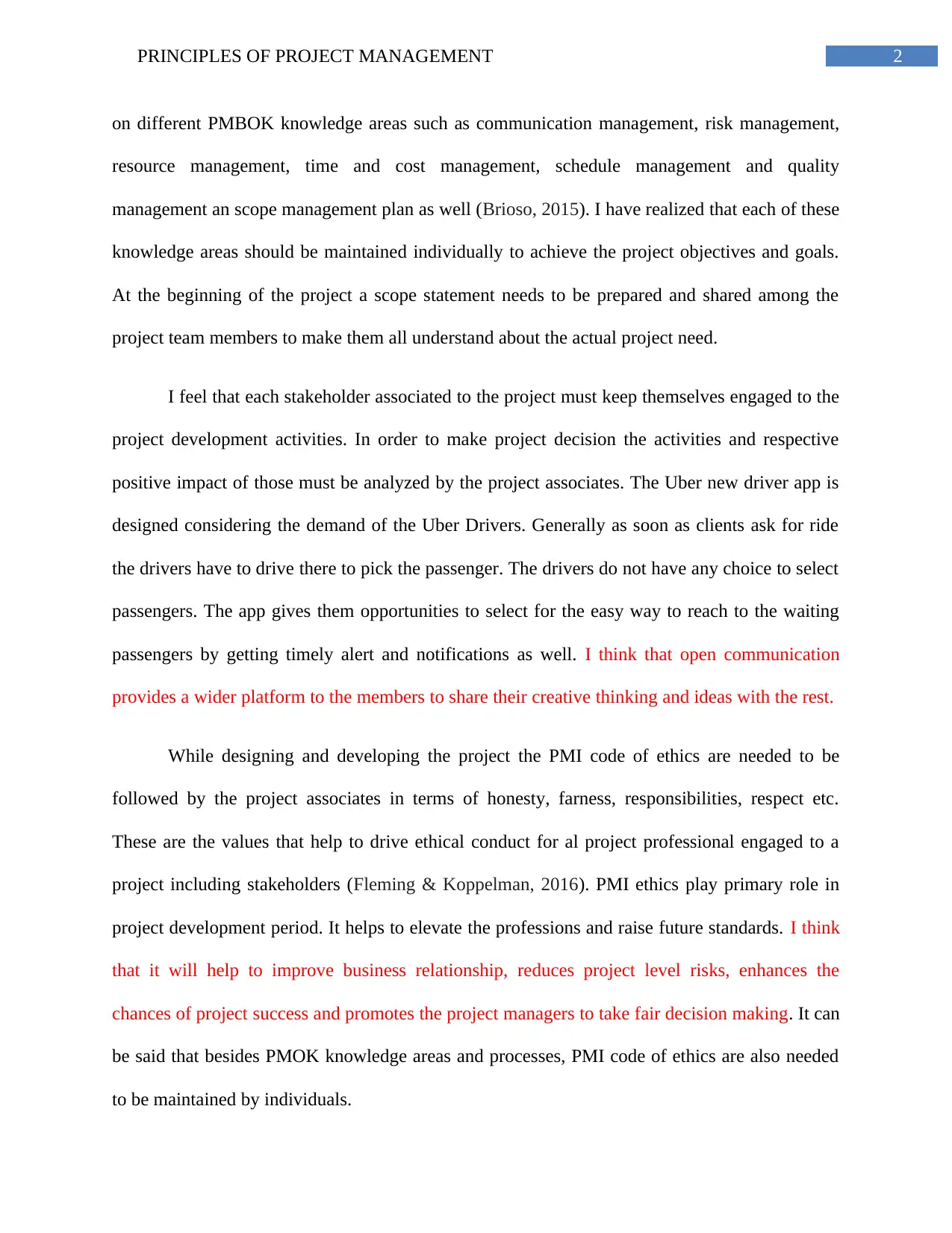
2PRINCIPLES OF PROJECT MANAGEMENT
on different PMBOK knowledge areas such as communication management, risk management,
resource management, time and cost management, schedule management and quality
management an scope management plan as well (Brioso, 2015). I have realized that each of these
knowledge areas should be maintained individually to achieve the project objectives and goals.
At the beginning of the project a scope statement needs to be prepared and shared among the
project team members to make them all understand about the actual project need.
I feel that each stakeholder associated to the project must keep themselves engaged to the
project development activities. In order to make project decision the activities and respective
positive impact of those must be analyzed by the project associates. The Uber new driver app is
designed considering the demand of the Uber Drivers. Generally as soon as clients ask for ride
the drivers have to drive there to pick the passenger. The drivers do not have any choice to select
passengers. The app gives them opportunities to select for the easy way to reach to the waiting
passengers by getting timely alert and notifications as well. I think that open communication
provides a wider platform to the members to share their creative thinking and ideas with the rest.
While designing and developing the project the PMI code of ethics are needed to be
followed by the project associates in terms of honesty, farness, responsibilities, respect etc.
These are the values that help to drive ethical conduct for al project professional engaged to a
project including stakeholders (Fleming & Koppelman, 2016). PMI ethics play primary role in
project development period. It helps to elevate the professions and raise future standards. I think
that it will help to improve business relationship, reduces project level risks, enhances the
chances of project success and promotes the project managers to take fair decision making. It can
be said that besides PMOK knowledge areas and processes, PMI code of ethics are also needed
to be maintained by individuals.
on different PMBOK knowledge areas such as communication management, risk management,
resource management, time and cost management, schedule management and quality
management an scope management plan as well (Brioso, 2015). I have realized that each of these
knowledge areas should be maintained individually to achieve the project objectives and goals.
At the beginning of the project a scope statement needs to be prepared and shared among the
project team members to make them all understand about the actual project need.
I feel that each stakeholder associated to the project must keep themselves engaged to the
project development activities. In order to make project decision the activities and respective
positive impact of those must be analyzed by the project associates. The Uber new driver app is
designed considering the demand of the Uber Drivers. Generally as soon as clients ask for ride
the drivers have to drive there to pick the passenger. The drivers do not have any choice to select
passengers. The app gives them opportunities to select for the easy way to reach to the waiting
passengers by getting timely alert and notifications as well. I think that open communication
provides a wider platform to the members to share their creative thinking and ideas with the rest.
While designing and developing the project the PMI code of ethics are needed to be
followed by the project associates in terms of honesty, farness, responsibilities, respect etc.
These are the values that help to drive ethical conduct for al project professional engaged to a
project including stakeholders (Fleming & Koppelman, 2016). PMI ethics play primary role in
project development period. It helps to elevate the professions and raise future standards. I think
that it will help to improve business relationship, reduces project level risks, enhances the
chances of project success and promotes the project managers to take fair decision making. It can
be said that besides PMOK knowledge areas and processes, PMI code of ethics are also needed
to be maintained by individuals.
⊘ This is a preview!⊘
Do you want full access?
Subscribe today to unlock all pages.

Trusted by 1+ million students worldwide
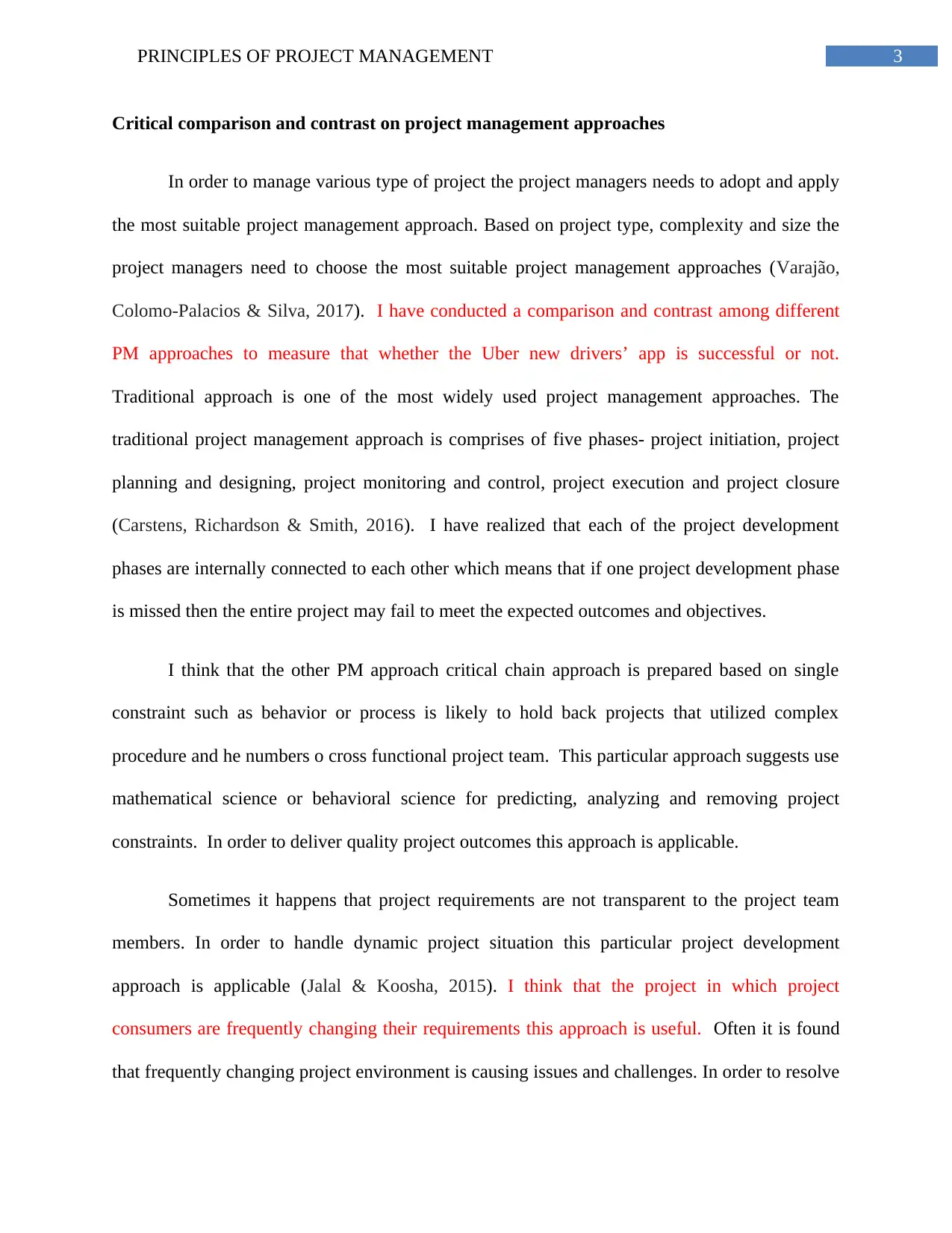
3PRINCIPLES OF PROJECT MANAGEMENT
Critical comparison and contrast on project management approaches
In order to manage various type of project the project managers needs to adopt and apply
the most suitable project management approach. Based on project type, complexity and size the
project managers need to choose the most suitable project management approaches (Varajão,
Colomo-Palacios & Silva, 2017). I have conducted a comparison and contrast among different
PM approaches to measure that whether the Uber new drivers’ app is successful or not.
Traditional approach is one of the most widely used project management approaches. The
traditional project management approach is comprises of five phases- project initiation, project
planning and designing, project monitoring and control, project execution and project closure
(Carstens, Richardson & Smith, 2016). I have realized that each of the project development
phases are internally connected to each other which means that if one project development phase
is missed then the entire project may fail to meet the expected outcomes and objectives.
I think that the other PM approach critical chain approach is prepared based on single
constraint such as behavior or process is likely to hold back projects that utilized complex
procedure and he numbers o cross functional project team. This particular approach suggests use
mathematical science or behavioral science for predicting, analyzing and removing project
constraints. In order to deliver quality project outcomes this approach is applicable.
Sometimes it happens that project requirements are not transparent to the project team
members. In order to handle dynamic project situation this particular project development
approach is applicable (Jalal & Koosha, 2015). I think that the project in which project
consumers are frequently changing their requirements this approach is useful. Often it is found
that frequently changing project environment is causing issues and challenges. In order to resolve
Critical comparison and contrast on project management approaches
In order to manage various type of project the project managers needs to adopt and apply
the most suitable project management approach. Based on project type, complexity and size the
project managers need to choose the most suitable project management approaches (Varajão,
Colomo-Palacios & Silva, 2017). I have conducted a comparison and contrast among different
PM approaches to measure that whether the Uber new drivers’ app is successful or not.
Traditional approach is one of the most widely used project management approaches. The
traditional project management approach is comprises of five phases- project initiation, project
planning and designing, project monitoring and control, project execution and project closure
(Carstens, Richardson & Smith, 2016). I have realized that each of the project development
phases are internally connected to each other which means that if one project development phase
is missed then the entire project may fail to meet the expected outcomes and objectives.
I think that the other PM approach critical chain approach is prepared based on single
constraint such as behavior or process is likely to hold back projects that utilized complex
procedure and he numbers o cross functional project team. This particular approach suggests use
mathematical science or behavioral science for predicting, analyzing and removing project
constraints. In order to deliver quality project outcomes this approach is applicable.
Sometimes it happens that project requirements are not transparent to the project team
members. In order to handle dynamic project situation this particular project development
approach is applicable (Jalal & Koosha, 2015). I think that the project in which project
consumers are frequently changing their requirements this approach is useful. Often it is found
that frequently changing project environment is causing issues and challenges. In order to resolve
Paraphrase This Document
Need a fresh take? Get an instant paraphrase of this document with our AI Paraphraser
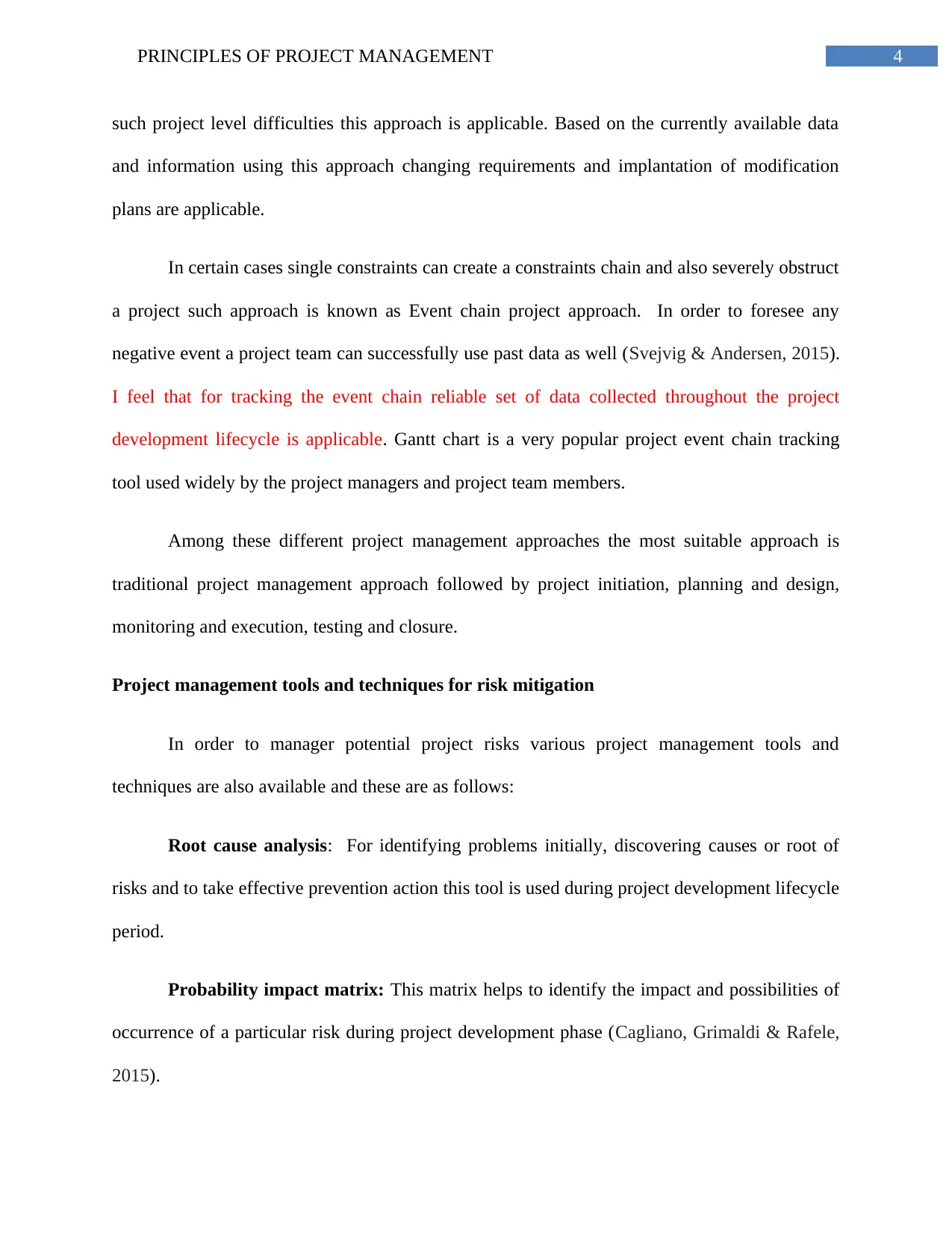
4PRINCIPLES OF PROJECT MANAGEMENT
such project level difficulties this approach is applicable. Based on the currently available data
and information using this approach changing requirements and implantation of modification
plans are applicable.
In certain cases single constraints can create a constraints chain and also severely obstruct
a project such approach is known as Event chain project approach. In order to foresee any
negative event a project team can successfully use past data as well (Svejvig & Andersen, 2015).
I feel that for tracking the event chain reliable set of data collected throughout the project
development lifecycle is applicable. Gantt chart is a very popular project event chain tracking
tool used widely by the project managers and project team members.
Among these different project management approaches the most suitable approach is
traditional project management approach followed by project initiation, planning and design,
monitoring and execution, testing and closure.
Project management tools and techniques for risk mitigation
In order to manager potential project risks various project management tools and
techniques are also available and these are as follows:
Root cause analysis: For identifying problems initially, discovering causes or root of
risks and to take effective prevention action this tool is used during project development lifecycle
period.
Probability impact matrix: This matrix helps to identify the impact and possibilities of
occurrence of a particular risk during project development phase (Cagliano, Grimaldi & Rafele,
2015).
such project level difficulties this approach is applicable. Based on the currently available data
and information using this approach changing requirements and implantation of modification
plans are applicable.
In certain cases single constraints can create a constraints chain and also severely obstruct
a project such approach is known as Event chain project approach. In order to foresee any
negative event a project team can successfully use past data as well (Svejvig & Andersen, 2015).
I feel that for tracking the event chain reliable set of data collected throughout the project
development lifecycle is applicable. Gantt chart is a very popular project event chain tracking
tool used widely by the project managers and project team members.
Among these different project management approaches the most suitable approach is
traditional project management approach followed by project initiation, planning and design,
monitoring and execution, testing and closure.
Project management tools and techniques for risk mitigation
In order to manager potential project risks various project management tools and
techniques are also available and these are as follows:
Root cause analysis: For identifying problems initially, discovering causes or root of
risks and to take effective prevention action this tool is used during project development lifecycle
period.
Probability impact matrix: This matrix helps to identify the impact and possibilities of
occurrence of a particular risk during project development phase (Cagliano, Grimaldi & Rafele,
2015).
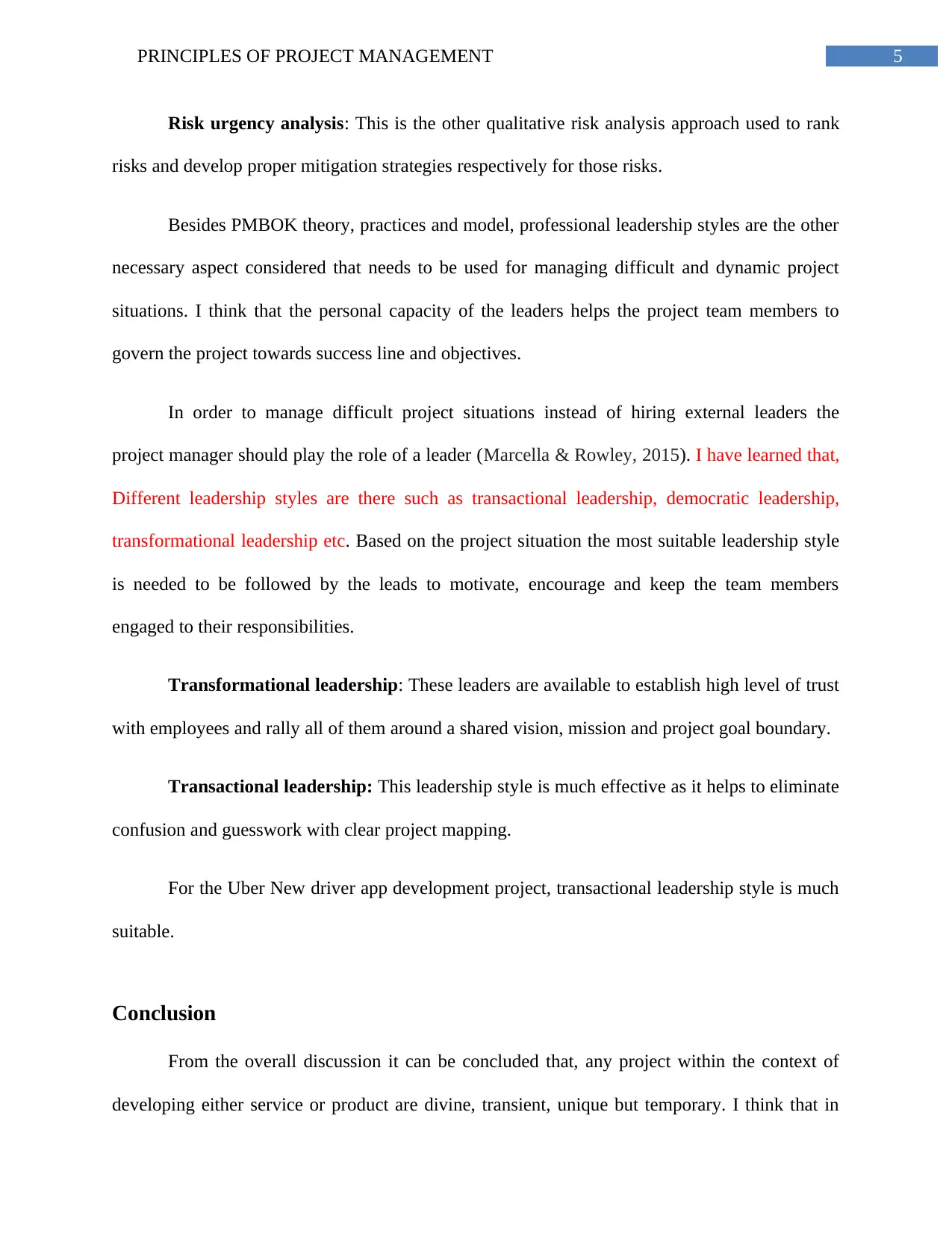
5PRINCIPLES OF PROJECT MANAGEMENT
Risk urgency analysis: This is the other qualitative risk analysis approach used to rank
risks and develop proper mitigation strategies respectively for those risks.
Besides PMBOK theory, practices and model, professional leadership styles are the other
necessary aspect considered that needs to be used for managing difficult and dynamic project
situations. I think that the personal capacity of the leaders helps the project team members to
govern the project towards success line and objectives.
In order to manage difficult project situations instead of hiring external leaders the
project manager should play the role of a leader (Marcella & Rowley, 2015). I have learned that,
Different leadership styles are there such as transactional leadership, democratic leadership,
transformational leadership etc. Based on the project situation the most suitable leadership style
is needed to be followed by the leads to motivate, encourage and keep the team members
engaged to their responsibilities.
Transformational leadership: These leaders are available to establish high level of trust
with employees and rally all of them around a shared vision, mission and project goal boundary.
Transactional leadership: This leadership style is much effective as it helps to eliminate
confusion and guesswork with clear project mapping.
For the Uber New driver app development project, transactional leadership style is much
suitable.
Conclusion
From the overall discussion it can be concluded that, any project within the context of
developing either service or product are divine, transient, unique but temporary. I think that in
Risk urgency analysis: This is the other qualitative risk analysis approach used to rank
risks and develop proper mitigation strategies respectively for those risks.
Besides PMBOK theory, practices and model, professional leadership styles are the other
necessary aspect considered that needs to be used for managing difficult and dynamic project
situations. I think that the personal capacity of the leaders helps the project team members to
govern the project towards success line and objectives.
In order to manage difficult project situations instead of hiring external leaders the
project manager should play the role of a leader (Marcella & Rowley, 2015). I have learned that,
Different leadership styles are there such as transactional leadership, democratic leadership,
transformational leadership etc. Based on the project situation the most suitable leadership style
is needed to be followed by the leads to motivate, encourage and keep the team members
engaged to their responsibilities.
Transformational leadership: These leaders are available to establish high level of trust
with employees and rally all of them around a shared vision, mission and project goal boundary.
Transactional leadership: This leadership style is much effective as it helps to eliminate
confusion and guesswork with clear project mapping.
For the Uber New driver app development project, transactional leadership style is much
suitable.
Conclusion
From the overall discussion it can be concluded that, any project within the context of
developing either service or product are divine, transient, unique but temporary. I think that in
⊘ This is a preview!⊘
Do you want full access?
Subscribe today to unlock all pages.

Trusted by 1+ million students worldwide
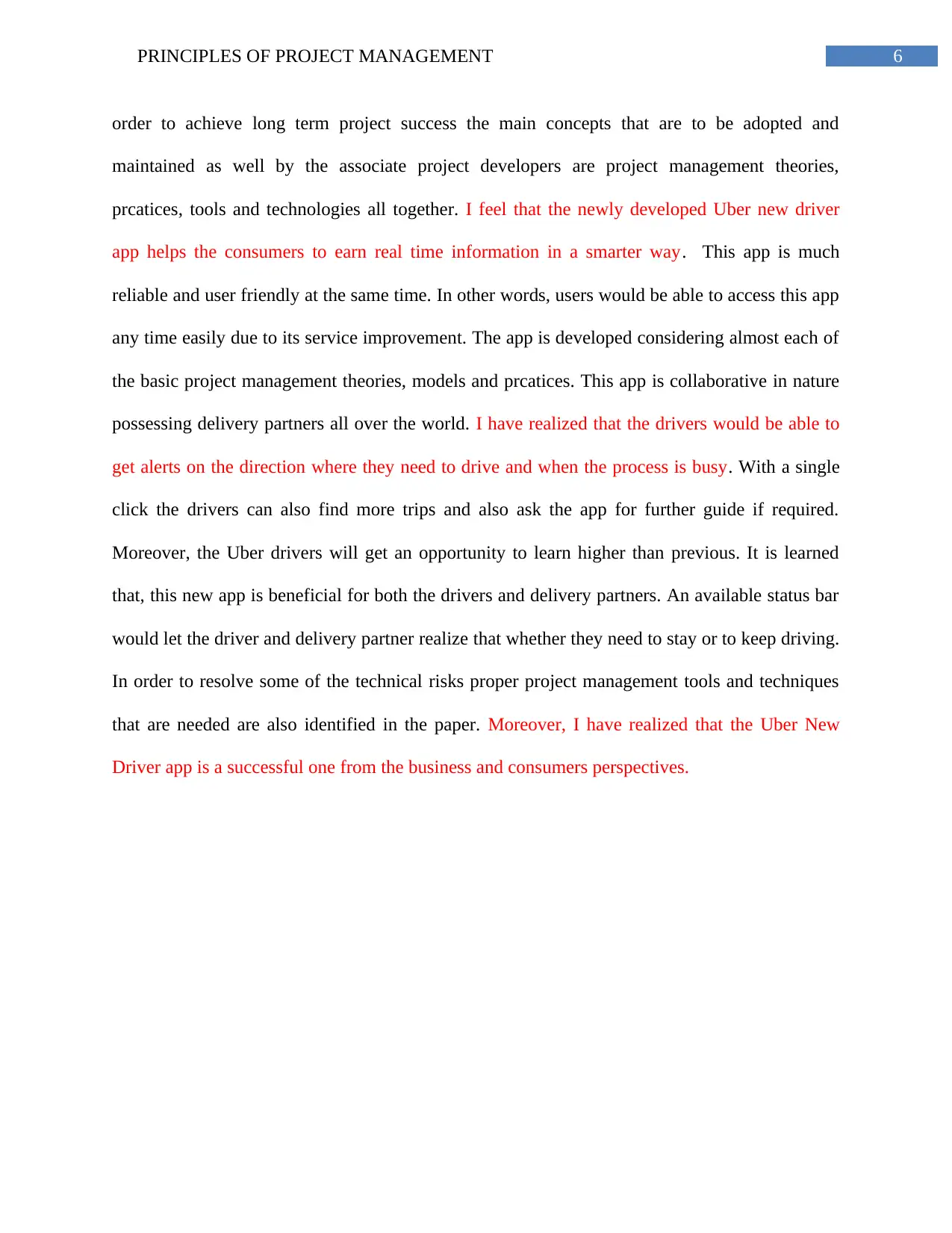
6PRINCIPLES OF PROJECT MANAGEMENT
order to achieve long term project success the main concepts that are to be adopted and
maintained as well by the associate project developers are project management theories,
prcatices, tools and technologies all together. I feel that the newly developed Uber new driver
app helps the consumers to earn real time information in a smarter way. This app is much
reliable and user friendly at the same time. In other words, users would be able to access this app
any time easily due to its service improvement. The app is developed considering almost each of
the basic project management theories, models and prcatices. This app is collaborative in nature
possessing delivery partners all over the world. I have realized that the drivers would be able to
get alerts on the direction where they need to drive and when the process is busy. With a single
click the drivers can also find more trips and also ask the app for further guide if required.
Moreover, the Uber drivers will get an opportunity to learn higher than previous. It is learned
that, this new app is beneficial for both the drivers and delivery partners. An available status bar
would let the driver and delivery partner realize that whether they need to stay or to keep driving.
In order to resolve some of the technical risks proper project management tools and techniques
that are needed are also identified in the paper. Moreover, I have realized that the Uber New
Driver app is a successful one from the business and consumers perspectives.
order to achieve long term project success the main concepts that are to be adopted and
maintained as well by the associate project developers are project management theories,
prcatices, tools and technologies all together. I feel that the newly developed Uber new driver
app helps the consumers to earn real time information in a smarter way. This app is much
reliable and user friendly at the same time. In other words, users would be able to access this app
any time easily due to its service improvement. The app is developed considering almost each of
the basic project management theories, models and prcatices. This app is collaborative in nature
possessing delivery partners all over the world. I have realized that the drivers would be able to
get alerts on the direction where they need to drive and when the process is busy. With a single
click the drivers can also find more trips and also ask the app for further guide if required.
Moreover, the Uber drivers will get an opportunity to learn higher than previous. It is learned
that, this new app is beneficial for both the drivers and delivery partners. An available status bar
would let the driver and delivery partner realize that whether they need to stay or to keep driving.
In order to resolve some of the technical risks proper project management tools and techniques
that are needed are also identified in the paper. Moreover, I have realized that the Uber New
Driver app is a successful one from the business and consumers perspectives.
Paraphrase This Document
Need a fresh take? Get an instant paraphrase of this document with our AI Paraphraser
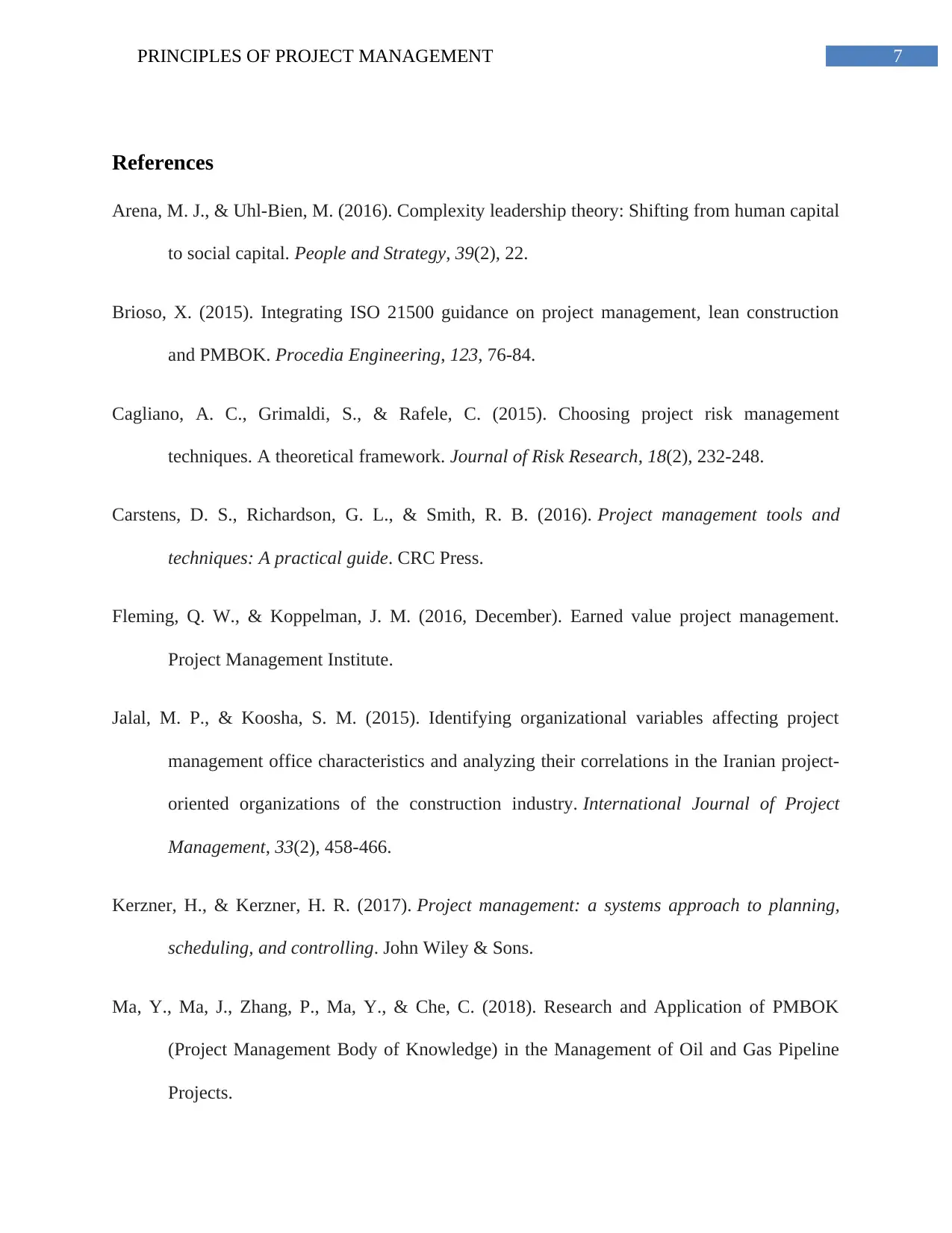
7PRINCIPLES OF PROJECT MANAGEMENT
References
Arena, M. J., & Uhl-Bien, M. (2016). Complexity leadership theory: Shifting from human capital
to social capital. People and Strategy, 39(2), 22.
Brioso, X. (2015). Integrating ISO 21500 guidance on project management, lean construction
and PMBOK. Procedia Engineering, 123, 76-84.
Cagliano, A. C., Grimaldi, S., & Rafele, C. (2015). Choosing project risk management
techniques. A theoretical framework. Journal of Risk Research, 18(2), 232-248.
Carstens, D. S., Richardson, G. L., & Smith, R. B. (2016). Project management tools and
techniques: A practical guide. CRC Press.
Fleming, Q. W., & Koppelman, J. M. (2016, December). Earned value project management.
Project Management Institute.
Jalal, M. P., & Koosha, S. M. (2015). Identifying organizational variables affecting project
management office characteristics and analyzing their correlations in the Iranian project-
oriented organizations of the construction industry. International Journal of Project
Management, 33(2), 458-466.
Kerzner, H., & Kerzner, H. R. (2017). Project management: a systems approach to planning,
scheduling, and controlling. John Wiley & Sons.
Ma, Y., Ma, J., Zhang, P., Ma, Y., & Che, C. (2018). Research and Application of PMBOK
(Project Management Body of Knowledge) in the Management of Oil and Gas Pipeline
Projects.
References
Arena, M. J., & Uhl-Bien, M. (2016). Complexity leadership theory: Shifting from human capital
to social capital. People and Strategy, 39(2), 22.
Brioso, X. (2015). Integrating ISO 21500 guidance on project management, lean construction
and PMBOK. Procedia Engineering, 123, 76-84.
Cagliano, A. C., Grimaldi, S., & Rafele, C. (2015). Choosing project risk management
techniques. A theoretical framework. Journal of Risk Research, 18(2), 232-248.
Carstens, D. S., Richardson, G. L., & Smith, R. B. (2016). Project management tools and
techniques: A practical guide. CRC Press.
Fleming, Q. W., & Koppelman, J. M. (2016, December). Earned value project management.
Project Management Institute.
Jalal, M. P., & Koosha, S. M. (2015). Identifying organizational variables affecting project
management office characteristics and analyzing their correlations in the Iranian project-
oriented organizations of the construction industry. International Journal of Project
Management, 33(2), 458-466.
Kerzner, H., & Kerzner, H. R. (2017). Project management: a systems approach to planning,
scheduling, and controlling. John Wiley & Sons.
Ma, Y., Ma, J., Zhang, P., Ma, Y., & Che, C. (2018). Research and Application of PMBOK
(Project Management Body of Knowledge) in the Management of Oil and Gas Pipeline
Projects.
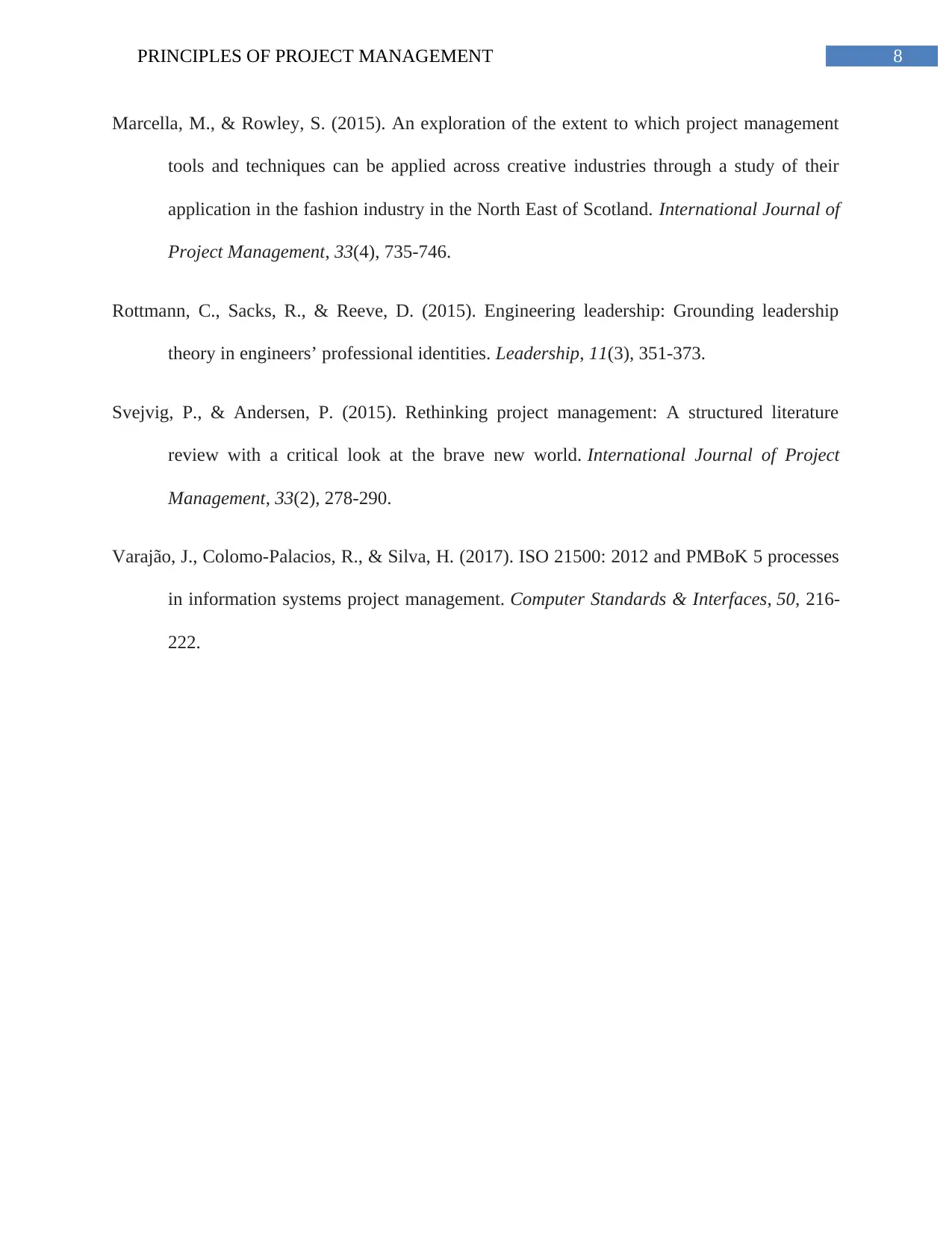
8PRINCIPLES OF PROJECT MANAGEMENT
Marcella, M., & Rowley, S. (2015). An exploration of the extent to which project management
tools and techniques can be applied across creative industries through a study of their
application in the fashion industry in the North East of Scotland. International Journal of
Project Management, 33(4), 735-746.
Rottmann, C., Sacks, R., & Reeve, D. (2015). Engineering leadership: Grounding leadership
theory in engineers’ professional identities. Leadership, 11(3), 351-373.
Svejvig, P., & Andersen, P. (2015). Rethinking project management: A structured literature
review with a critical look at the brave new world. International Journal of Project
Management, 33(2), 278-290.
Varajão, J., Colomo-Palacios, R., & Silva, H. (2017). ISO 21500: 2012 and PMBoK 5 processes
in information systems project management. Computer Standards & Interfaces, 50, 216-
222.
Marcella, M., & Rowley, S. (2015). An exploration of the extent to which project management
tools and techniques can be applied across creative industries through a study of their
application in the fashion industry in the North East of Scotland. International Journal of
Project Management, 33(4), 735-746.
Rottmann, C., Sacks, R., & Reeve, D. (2015). Engineering leadership: Grounding leadership
theory in engineers’ professional identities. Leadership, 11(3), 351-373.
Svejvig, P., & Andersen, P. (2015). Rethinking project management: A structured literature
review with a critical look at the brave new world. International Journal of Project
Management, 33(2), 278-290.
Varajão, J., Colomo-Palacios, R., & Silva, H. (2017). ISO 21500: 2012 and PMBoK 5 processes
in information systems project management. Computer Standards & Interfaces, 50, 216-
222.
⊘ This is a preview!⊘
Do you want full access?
Subscribe today to unlock all pages.

Trusted by 1+ million students worldwide
1 out of 9
Related Documents
Your All-in-One AI-Powered Toolkit for Academic Success.
+13062052269
info@desklib.com
Available 24*7 on WhatsApp / Email
![[object Object]](/_next/static/media/star-bottom.7253800d.svg)
Unlock your academic potential
Copyright © 2020–2025 A2Z Services. All Rights Reserved. Developed and managed by ZUCOL.





